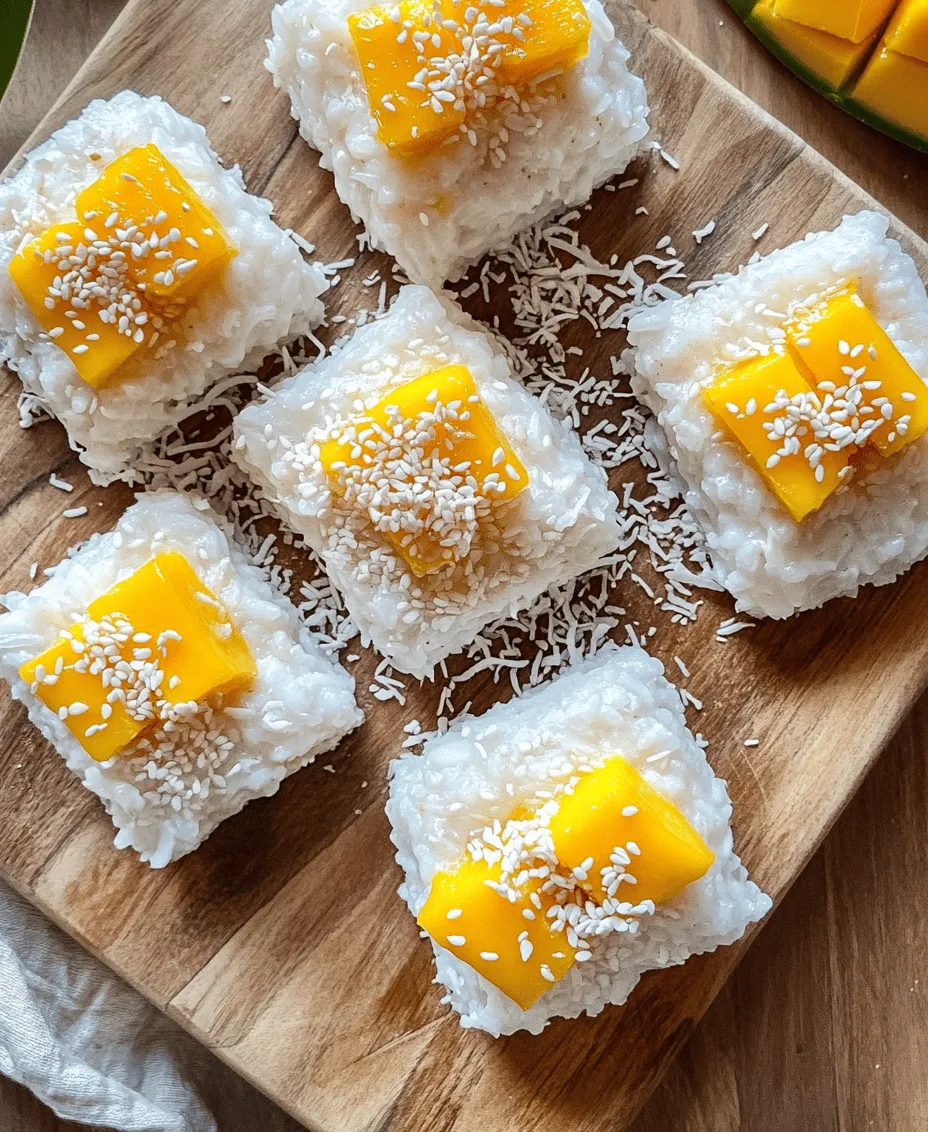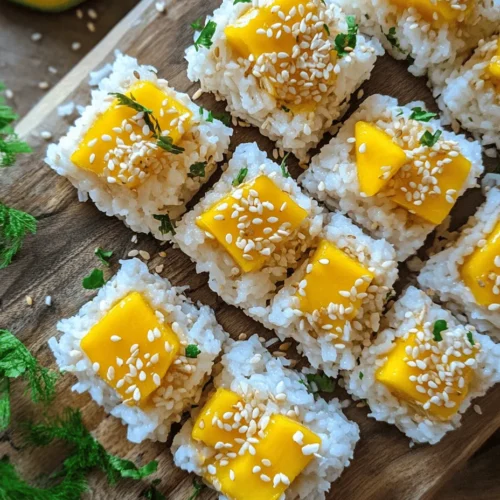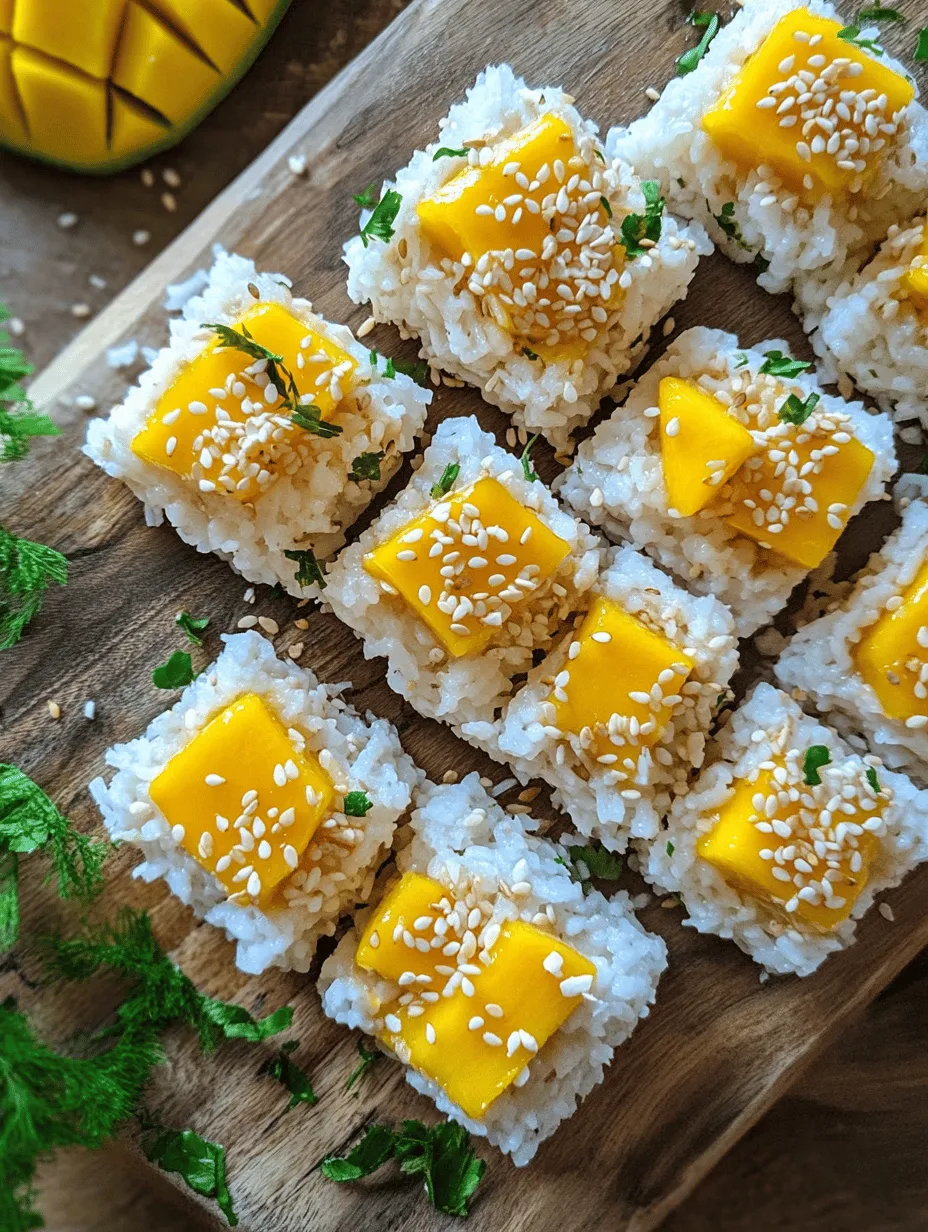Coconut Delight Rice Cakes are a delightful fusion of flavors and textures that bring a tropical twist to your dessert table. This recipe is rooted in the rich traditions of various Asian cuisines, where rice cakes have long been enjoyed during celebrations and as snacks. With the fragrant notes of jasmine rice and the creamy richness of coconut milk, these cakes are not only easy to prepare but also offer a satisfying treat for any occasion. Whether you’re hosting a summer gathering, celebrating a special event, or simply satisfying your sweet tooth, Coconut Delight Rice Cakes are sure to impress.
As you embark on this culinary journey, we’ll explore the cultural significance of rice cakes, the health benefits of coconut, and some creative serving suggestions that will elevate your dining experience. Prepare to indulge in a dish that is as pleasing to the palate as it is visually appealing.
Understanding the Ingredients
Exploring Jasmine Rice
Jasmine rice is a long-grain variety known for its delicate floral aroma and slightly sticky texture when cooked. Originating from Thailand, this rice is often favored for its subtle sweetness, making it an ideal choice for desserts. The flavor profile of jasmine rice complements the rich taste of coconut milk, creating a harmonious blend that enhances the overall experience of the Coconut Delight Rice Cakes.
Nutritional Benefits of Jasmine Rice:
– Energy Source: Jasmine rice is primarily composed of carbohydrates, providing a quick source of energy.
– Gluten-Free: This rice is naturally gluten-free, making it suitable for those with gluten sensitivities or celiac disease.
– Low in Fat: It contains minimal fat, allowing you to enjoy a guilt-free dessert.
The Role of Coconut Milk
Coconut milk is a key ingredient in many tropical dishes, and its incorporation into Coconut Delight Rice Cakes takes the flavor to another level. The creamy texture and subtle sweetness of coconut milk not only enhance the taste of the rice cakes but also contribute to their moistness.
Health Benefits of Coconut Milk:
– Rich in Nutrients: Coconut milk is a good source of vitamins and minerals, including vitamin C, E, B vitamins, and iron.
– Healthy Fats: It contains medium-chain triglycerides (MCTs), which may provide quick energy and support weight management.
– Hydration: Coconut milk can aid in hydration, making it a refreshing addition to your diet.
Importance of Brown Sugar
When it comes to sweetening your Coconut Delight Rice Cakes, brown sugar is the preferred choice. Unlike white sugar, brown sugar retains some molasses, which gives it a richer flavor and a hint of caramel-like sweetness.
Health Aspects of Using Brown Sugar:
– Mineral Content: Brown sugar contains small amounts of minerals such as calcium, potassium, and iron, which are stripped away during the refining process of white sugar.
– Lower Glycemic Index: It may have a slightly lower glycemic index compared to white sugar, leading to a slower rise in blood sugar levels.
The Significance of Vanilla and Salt
Vanilla extract is often considered the secret ingredient in many dessert recipes, and it plays a vital role in enhancing the overall sweetness of the Coconut Delight Rice Cakes. The aromatic qualities of vanilla complement the flavors of coconut and jasmine rice, creating a more complex and enjoyable taste.
Salt, on the other hand, is crucial in balancing flavors. While it may seem counterintuitive to add salt to a sweet dish, a pinch can elevate the sweetness and round out the overall flavor profile of the cakes.
Overview of Additional Toppings
To take your Coconut Delight Rice Cakes to the next level, consider adding some fresh, vibrant toppings.
– Fresh Mango: Sliced or diced fresh mango adds a tropical appeal and a burst of natural sweetness that pairs beautifully with the coconut flavor.
– Toasted Sesame Seeds: Sprinkling toasted sesame seeds on top not only enhances the visual appeal but also adds a delightful crunch and nutty flavor, creating a perfect contrast to the soft texture of the cakes.
Step-by-Step Preparation of Coconut Delight Rice Cakes
Now that you are familiar with the key ingredients, it’s time to dive into the preparation process. Follow these step-by-step instructions to create your own batch of Coconut Delight Rice Cakes.
Preparing the Jasmine Rice
The first step in creating Coconut Delight Rice Cakes is preparing the jasmine rice. Rinsing the rice is crucial to remove excess starch, which can make the cakes gummy rather than soft and fluffy.
Importance of Rinsing Rice:
Rinsing jasmine rice before cooking removes the surface starch, preventing clumping and resulting in a more pleasant texture.
Techniques for Proper Rinsing and Draining:
1. Measure the Rice: Start by measuring the desired amount of jasmine rice, typically about 1 cup for a small batch of rice cakes.
2. Rinse Under Cold Water: Place the rice in a fine-mesh strainer and rinse it under cold running water. Gently swirl the rice with your hand to ensure all grains are rinsed thoroughly.
3. Continue Rinsing: Continue rinsing until the water runs clear, indicating that most of the surface starch has been removed.
4. Drain Well: After rinsing, allow the rice to drain completely to remove excess water before cooking.
Mixing the Ingredients
Once the rice is properly prepared, it’s time to mix it with the other key ingredients. The goal is to achieve a smooth, cohesive mixture that will hold together when cooked.
Combining Rice with Coconut Milk and Other Ingredients:
1. Combine in a Mixing Bowl: In a large mixing bowl, combine the rinsed jasmine rice with coconut milk, brown sugar, vanilla extract, and a pinch of salt.
2. Stir Gently: Use a silicone spatula or wooden spoon to gently mix the ingredients together. Be careful not to overmix, as this could break the rice grains.
3. Check the Consistency: The mixture should be thick but pourable. If it appears too dry, add a little more coconut milk until you reach the desired consistency.
Cooking Process
The cooking method for Coconut Delight Rice Cakes involves both boiling and simmering to ensure the rice is perfectly cooked and infused with coconut flavor.
Boiling and Simmering Techniques:
1. Prepare a Steamer: If you have a bamboo steamer or a traditional steamer, prepare it by lining it with parchment paper or banana leaves to prevent sticking.
2. Bring Water to a Boil: Fill a pot with water and bring it to a rolling boil. The steam from the boiling water will cook the rice cakes.
3. Pour the Mixture: Carefully pour the rice mixture into the prepared steamer, spreading it out evenly.
4. Cover and Steam: Cover the steamer with a lid and let the rice cakes steam for approximately 20-30 minutes. You’ll know they are done when the top appears set and firm to the touch.
What to Look for in Properly Cooked Rice:
– The rice should be tender and fully cooked, with no crunchiness remaining.
– A toothpick inserted into the center should come out clean, indicating that the cakes are ready to be removed from the steamer.
By following these detailed steps, you’ll create Coconut Delight Rice Cakes that are not only delicious but also a reflection of the cultural significance and health benefits of the ingredients used. Stay tuned for the next part, where we will provide serving suggestions and additional tips to make your dish even more delightful.

Incorporating Flavor Enhancers
To elevate your Coconut Delight Rice Cakes, incorporating flavor enhancers is key. Begin by adding a splash of vanilla extract, which infuses the mixture with a warm, aromatic note that complements the sweetness of the coconut. Aim for about one teaspoon; this small addition can significantly enhance the overall flavor profile of your dish.
Next, introduce shredded coconut into your mixture. While coconut milk provides moisture and richness, shredded coconut adds texture and a burst of coconut flavor. Use unsweetened shredded coconut to maintain control over the sweetness of your rice cakes. The combination of these ingredients not only deepens the flavor but also creates a delightful contrast in texture, making each bite a delicious experience.
Thorough mixing is crucial at this stage. Ensure that the vanilla and shredded coconut are evenly distributed throughout the rice mixture. This will guarantee that every bite of your Coconut Delight Rice Cakes bursts with flavor. A rubber spatula or wooden spoon can facilitate a gentle but thorough incorporation, minimizing clumping and ensuring a smooth consistency.
Setting the Rice Cakes
Once your mixture is well-combined, it’s time to transfer it to your prepared baking dish. Choose a dish that is appropriate for the quantity of the rice cake mixture; a square or rectangular baking pan works well for even cooking. Lightly grease the dish with cooking spray or a thin layer of coconut oil to prevent sticking.
When pouring the mixture into the baking dish, use a spatula to spread it evenly across the base. To achieve even layers, it’s crucial to press down firmly but gently. You can use the back of a measuring cup or your hands (dampened to prevent sticking) to compact the mixture evenly. This step is vital, as it influences the texture of the final product—too loose, and the rice cakes may crumble; too compact, and they may become dense and chewy.
Chilling and Cutting the Rice Cakes
After setting the mixture, it’s essential to let it cool and firm up. Cover the dish with plastic wrap or a clean kitchen towel and place it in the refrigerator for at least two to three hours. Chilling allows the ingredients to meld together, enhancing the flavors and making the rice cakes easier to cut.
Once adequately chilled, it’s time to cut your rice cakes. Use a sharp knife to slice through the chilled mixture, and consider warming the knife under hot water and drying it before cutting. This technique helps achieve clean, even slices. Aim for squares or rectangles, depending on your preference, and ensure each piece is similar in size for a uniform presentation.
Serving Suggestions for Coconut Delight Rice Cakes
Garnishing Ideas
Garnishing can elevate the visual appeal and flavor of your Coconut Delight Rice Cakes. Fresh mango is an excellent choice; its vibrant color and juicy texture provide a delightful contrast to the dense rice cakes. Simply peel and slice the mango, then fan it out on the serving plate or place it alongside the rice cakes.
Another option is to sprinkle toasted sesame seeds over the top. The nutty flavor and crunchy texture of sesame seeds complement the sweetness of the coconut beautifully, creating a sophisticated finish. To toast sesame seeds, place them in a dry skillet over medium heat, stirring frequently until they are golden brown.
Pairing with Other Dishes
Coconut Delight Rice Cakes can be served as a standalone dessert or as part of a larger meal. They pair wonderfully with tropical fruit salads or can be served alongside a refreshing coconut yogurt for a delightful brunch spread. The lightness of the rice cakes makes them an ideal complement to heavier main courses, such as grilled meats or spicy curries, adding a sweet balance to the meal.
For beverages, consider pairing these rice cakes with a light, citrusy iced tea or a coconut-infused smoothie. These drinks enhance the tropical theme and refresh the palate between bites.
Cultural Context of Rice Cakes
Rice cakes hold a significant place in various culinary traditions around the world. From Korean tteok to Japanese mochiko, rice cakes are often associated with celebrations and communal gatherings. The versatility of rice as a base ingredient allows for a wide range of flavor profiles and textures, making them a beloved treat across cultures.
Coconut Delight Rice Cakes fit seamlessly into modern culinary trends, particularly the increasing popularity of gluten-free and plant-based foods. By using coconut as a primary ingredient, these rice cakes celebrate natural flavors while catering to dietary preferences. Their simplicity and adaptability make them a fitting choice for both traditional celebrations and contemporary dining experiences.
Health Benefits of Coconut Delight Rice Cakes
Nutritional Breakdown
Coconut Delight Rice Cakes not only offer a delightful treat but also come packed with nutritional benefits. Key ingredients like coconut milk provide healthy fats, which are essential for energy and can help keep you feeling full longer. Shredded coconut is a source of dietary fiber, supporting digestive health, while rice contributes carbohydrates for energy.
When made with minimal added sugars, these rice cakes can be a relatively low-calorie dessert option for those looking to indulge without overdoing it. Additionally, they can be portioned easily, allowing for controlled servings.
Suitable for Various Diets
One of the standout features of Coconut Delight Rice Cakes is their suitability for various dietary preferences. With a gluten-free base, they are an excellent choice for individuals with gluten sensitivity or celiac disease. The use of coconut milk and shredded coconut means that they are naturally dairy-free, making them suitable for those following a vegan lifestyle.
For added flexibility, you can customize the recipe by substituting ingredients based on individual dietary needs. For example, using brown rice instead of white rice can enhance the fiber content, while incorporating alternative sweeteners can cater to those reducing sugar intake.
Conclusion
Coconut Delight Rice Cakes are more than just a dessert; they embody a blend of cultural heritage and modern culinary creativity. With their delightful flavors and simple preparation, these rice cakes can become a staple in your kitchen. By understanding the ingredients and following the recipe, you can create a memorable treat that is sure to impress family and friends alike.
Whether enjoyed as a sweet end to a meal or a unique snack, these rice cakes offer a taste of the tropics that will leave you craving more. Their versatility in garnishing, pairing, and dietary adaptability makes them a wonderful addition to any gathering or everyday menu. Embrace the joy of making and sharing Coconut Delight Rice Cakes and discover the pleasure they bring to your table!



